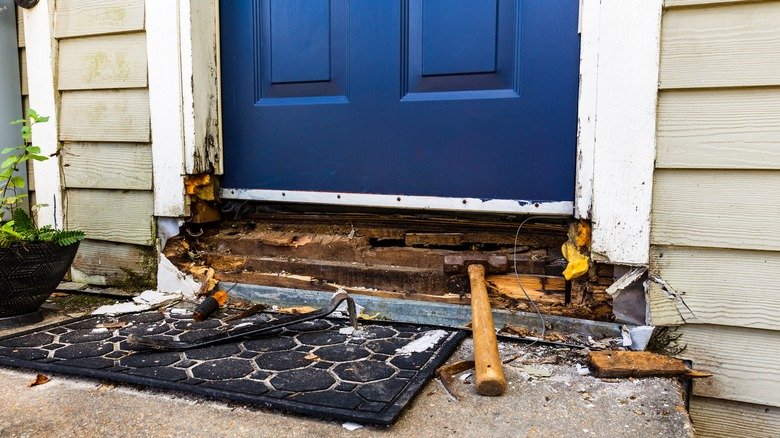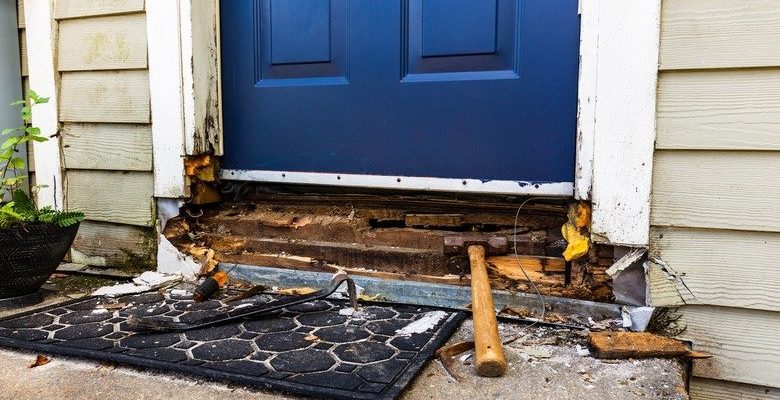
The truth is, humid climates and wood thresholds have always had a bit of a love-hate relationship. Sure, wood brings that warm, welcoming feel to your entryway, but it’s also a magnet for moisture. And once moisture gets in? Well, rot isn’t far behind. If you’ve got a wood threshold from a major brand like Masonite, JELD-WEN, or a universal fit model, the story’s usually the same: as soon as the air gets steamy, problems start to crop up.
Let me explain exactly why your wood door threshold seems to wither away faster than you’d expect—and what you can do about it. Here’s what’s really going on when humidity and wood thresholds meet.
How Humidity Supercharges Wood Rot in Door Thresholds
Honestly, if rot had a favorite climate, it’d choose somewhere humid every time. High humidity means the air is packed with water vapor, and wood is naturally absorbent—think of it as a sponge with good manners. That means when there’s moisture hanging around, the wood threshold is quietly soaking it up every day, bit by bit.
As wood absorbs all that extra moisture, a few things start happening. The fibers swell and lose their structure, which makes the threshold softer and easier for fungi to invade. Once wood’s moisture content climbs above about 20%, it becomes prime real estate for wood-destroying fungi—the real culprits behind rot. These fungi break down the wood from the inside out, turning your sturdy threshold into something crumbly and weak.
Here’s the thing: it’s not usually rainwater or puddles doing the damage (although those don’t help). Even without direct water contact, constant humidity will keep feeding the cycle. A Masonite or JELD-WEN door threshold with even small gaps in the finish or caulk can start this downhill slide without you noticing until it’s too late.
Common Signs Your Wood Door Threshold Is Rotting
Before you can stop the rot, you have to spot it. Sometimes, the damage is obvious. Other times, it hides under a layer of paint or stain—only to pop up when you least expect it. So, how do you know if your threshold’s in trouble?
- Soft spots: Step on your threshold—does it feel spongy or give under your weight?
- Peeling paint or finish: If the protective coating is bubbling, cracking, or coming off, moisture might already be lurking underneath.
- Discoloration or black spots: Dark streaks, gray patches, or black splotches can mean fungi are at work.
- Visible mold or mildew: If you see fuzzy, green, or black growth, it’s a red flag.
- Cracks and splitting: As wood expands and contracts with moisture, it can start to crack.
A universal remote control for your door (if you have electronic locks or sensors) won’t spot these signs for you. This is all about keeping an eye out and catching the little changes before they get worse.
What Makes Wooden Thresholds So Vulnerable?
You might be wondering why wooden thresholds seem to be singled out. After all, other parts of your house—like window trim or deck boards—deal with humidity too. But thresholds have a few unique challenges stacked against them:
- Constant traffic: Every time you walk in or out, your shoes bring water and dirt onto the wood. That’s more opportunity for moisture to work its way in—even with the best finishes.
- Low to the ground: Thresholds sit right at the bottom of your doorway, where water from rain, puddles, or even mopping can pool and seep in.
- Finish wear and tear: Door thresholds get scuffed, scraped, and banged into. Even the toughest factory finish from a premium brand (like Masonite) will eventually wear thin, opening up microgaps where water sneaks through.
- Edge exposure: The edges of most thresholds are hard to seal perfectly, so they tend to let water in from the sides, especially during storms or humid nights.
All of these factors combine to make your wood threshold the front-line soldier in the battle against rot—and sometimes, it just can’t hold the line.
How Does Rot Actually Start and Spread?
Rot isn’t like a switch you flip. It’s more like a slow domino effect. Once fungi land on damp wood, they start breaking down the tough cellulose inside. This process feeds the fungus, which leads to even more decay. It’s a cycle that doesn’t care whether you have a fancy JELD-WEN threshold or an older, generic one.
The trouble with humid climates is that they keep the wood’s moisture level high for long stretches—weeks or even months. Tiny spores (think of them as microscopic seeds) are floating around all the time, waiting for the perfect damp spot to take root.
Once rot starts at one edge or corner of the threshold, it spreads through the wood’s porous structure. Even if you dry out the surface, the inside can still be wet. That’s why small patches of rot can quickly turn into larger, soft zones that threaten the whole door frame.
Rot is relentless: once it gets a foothold, it uses every damp day to spread—even when you can’t see it.
Why Don’t Metal or Composite Thresholds Rot?
Let’s talk alternatives for a second. You might have seen aluminum, PVC, or composite thresholds for sale at the local hardware store. Here’s why those options shrug off humid climates while wood struggles.
Metal and composite thresholds don’t absorb water. They can get wet, sure—but they don’t soak it up, so fungi don’t get a chance to move in. Aluminum thresholds, for example, might corrode if they’re scratched or the finish is damaged, but they won’t rot away from the inside. Composite materials are even more stubborn, mixing wood fibers with plastic or resins to create something that’s tough for moisture to attack.
You might lose that classic, warm look of real wood, but if you’re tired of replacing rotted thresholds, it’s a swap worth considering. Some universal-fit composite thresholds even come pre-finished and ready to install, making the upgrade quick and painless.
Ways to Prevent Rot in Wood Door Thresholds (Even in Humid Climates)
Here’s the good news: you don’t have to surrender to rot. With a little extra care, you can protect your wood threshold even when the forecast calls for 90% humidity and afternoon thunderstorms.
- Keep it sealed: Check that the finish or paint is intact, especially around the edges. Touch up any worn spots or cracks as soon as you notice them.
- Use high-quality caulk: Seal every gap where water could sneak in—between the threshold and the door frame, or where the wood meets the floor.
- Avoid standing water: Sweep away puddles after a storm and lift wet doormats so moisture doesn’t get trapped underneath.
- Ventilate when you can: If you have air conditioning or a dehumidifier, use them to keep indoor humidity down. On muggy days, even a fan by the door can help dry things out a bit faster.
- Inspect regularly: Make it a habit to check for soft spots or damage every few months—especially after a wet season.
If you sync this regular check-in with other home maintenance—like resetting your smart lock or pairing your universal remote for the door—you’ll stay ahead of problems before they get expensive.
When Should You Replace a Wood Threshold?
Sometimes, no amount of patching or painting will save a threshold that’s already too far gone. If your wood threshold crumbles under pressure, has deep cracks, or you’re dealing with persistent mold, it’s probably time to start fresh.
Replacing a wooden threshold is a DIY project for some, but if you’re not handy, it’s worth calling in a pro—especially if you want to swap for a metal or composite version. New thresholds usually come with clear instructions (sort of like programming a universal remote), and modern designs often make for a cleaner, longer-lasting seal.
Here’s an extra tip: If you do replace your threshold, consider how well it pairs with your climate and home style. Universal-fit options make it easy, but if you’re sticking with wood, go for dense, rot-resistant species like mahogany, teak, or even pressure-treated pine—and give it a solid finish before installation.
The Bottom Line: Winning the Battle Against Rot
Living in a humid climate means you’re always going to be fighting the elements, especially when it comes to wood door thresholds. But with a mix of smart prevention, regular maintenance, and maybe a willingness to switch to sturdier materials, you can keep rot from turning your entryway into a recurring repair headache.
At the end of the day, it’s about staying vigilant and working with—not against—your home’s climate. Whether you’re sticking with a classic Masonite or JELD-WEN wood threshold or jumping to a modern composite, understanding how humidity, wood, and rot interact makes all the difference. Take a little time now, save a lot of frustration later, and keep your home’s entry looking sharp—no matter how sticky the air gets.
